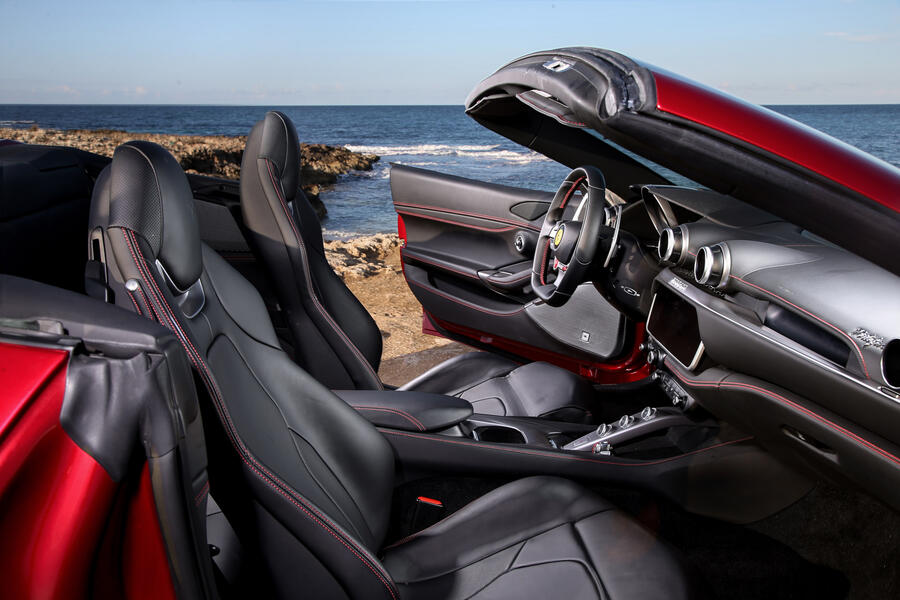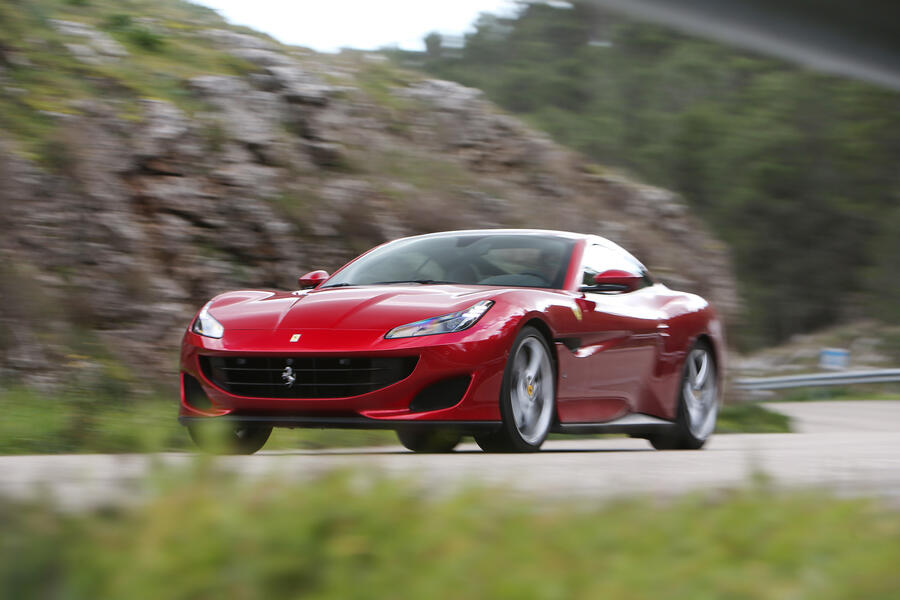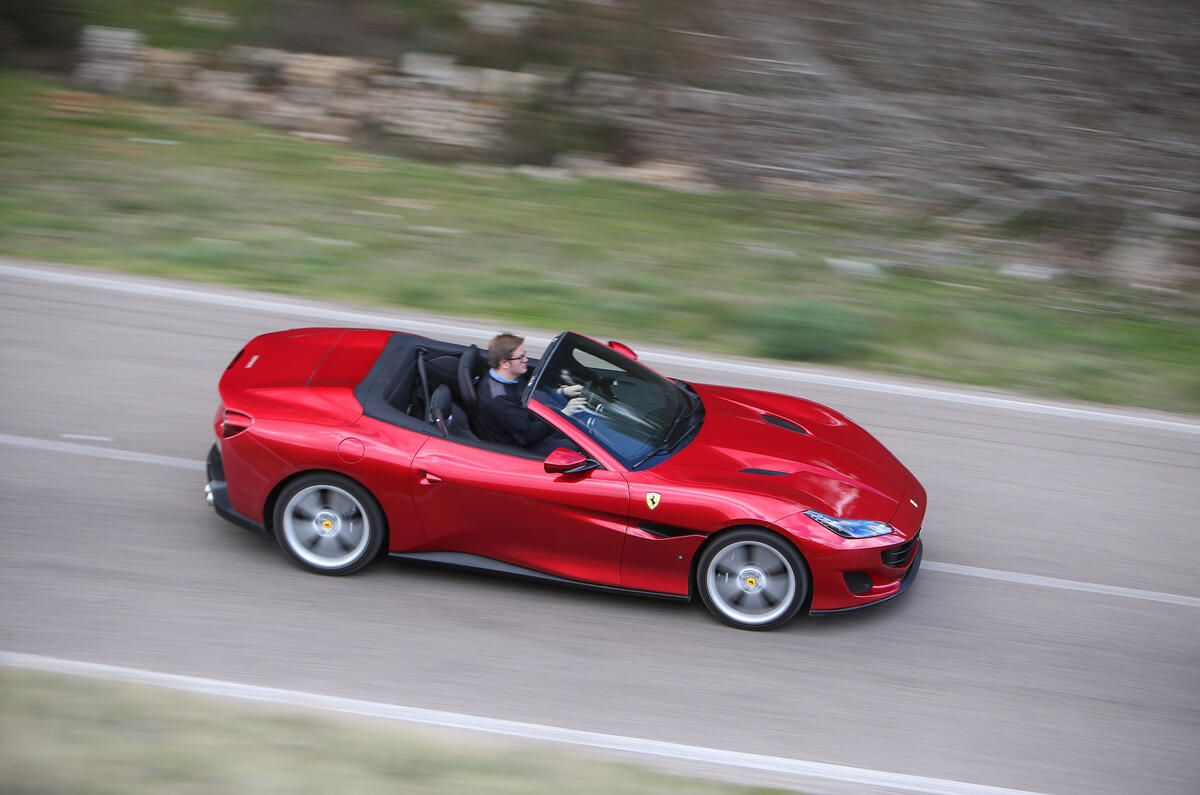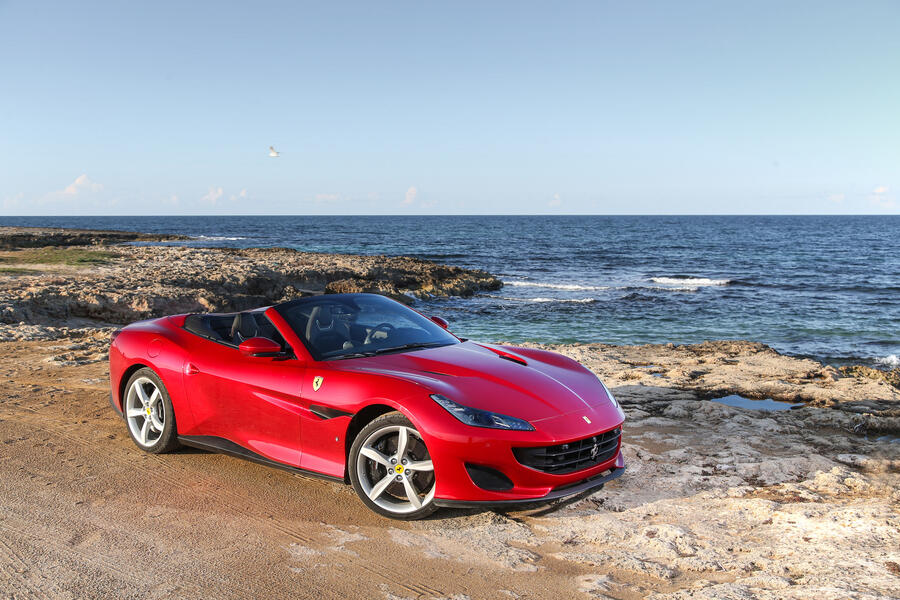The Portofino, like its more export-market-savvy model name, is all-new. The car’s styling may be characteristically dressy, but it undoubtedly makes for a much better proportioned and visually appealing car than the California was. With the roof up, there are even shades of the Daytona about the Portofino’s recumbent silhouette.
Underneath the attentively creased body panels, meanwhile, there’s a body-in-white that’s at once lighter and 35% more rigid than the California’s. The car’s suspension has been stiffened, its magnetorheological adaptive dampers retuned and its steering system both quickened and switched over from hydraulic power assistance to electromechanical.
Under the bonnet, a reappraisal of induction and exhaust design of the car’s 3.9-litre, 90-degree, flat-plane-crank, twin-turbo V8, together with the adoption of some new internals, conjures an additional 38bhp of peak power. The Portofino’s V8 is unusual among the latest force-fed equivalents because the exhaust sides of its cylinder heads are the outer ones, and so its turbos are mounted low and wide rather than in the configuration that Audi and Mercedes-AMG call a ‘hot V’.
Ferrari says it experimented with both layouts but this one packages best in both the Portofino and 488, and delivers less exhaust back pressure and a lower centre of gravity than the alternative would. And while Ferrari may only have liberated 4lb ft of additional torque here, given that it has also saved 80kg in the car’s kerbweight, this car trumps Aston Martin’s equally new DB11 Volante on power to weight ratio by more than 75bhp-per-tonne.
Remember when Maranello’s idea of an infotainment system came with a two-inch-wide monochrome display strip and navigation instructions harder to follow than the thinking behind Donald Trump’s international trade policy? How things change. The Portofino’s driver gets the familiar duo of 5in colour instrument displays flanking the central analogue rev-counter (which remain a bit busy and unintuitive), and the passenger gets their own widescreen touch-sensitive display too (though only as a £3300 option).
But the whole collection is dominated by a 10.3in central display that carries navigation mapping you can easily browse; that displays routes that you can easily follow; and that generally collects digital consoles for the car’s variously configurable systems that make mastering them uncharacteristically straightforward. For a convenience-minded GT car, that’s not a bad start.
Here’s another surprise: comfy leather seats with extendable cushions which, fair’s fair, are certainly less of a steep drop to get into than a 488’s. The Portofino’s cabin remains a way off the level of Mercedes-AMG or Audi for perceived quality, but it gives little up to either McLaren or Aston Martin.

The Portofino’s exhaust, meanwhile, has an electronically controlled bypass valve, making it louder or quieter depending on the drive mode you’ve selected on the familiar ‘manettino’ switch. It remains quietish in ‘comfort’ mode, until you use more than about 50% throttle – but makes a lovely, brash, brassy racket if you engage ‘sport’. The engine revs to a tremulous 7500rpm; it has a huge swell of mid-range torque; and it responds crisply at all times and feels unusually progressive in its power delivery for a highly stressed turbo. It’s always a cut well above an AMG or Audi V8 for dramatic character, in other words. Very Ferrari. But is it very grand tourer? Perhaps not.
The gearbox, too, gives further impetus to the slowly coagulating sense that the car’s identity is slightly muddled, and permanently at odds with itself. The twin-clutch unit is at its best when you’re shifting gears manually using the column-mounted paddles, when it thunks each up- and down-shift through with real speed and vigour. But it’s unconvincing when you just leave it in ‘auto’ mode, often timing its shifts with frustrating hesitancy, feeling a touch clumsy on step-off and when manoeuvring, and refusing to creep as you lift off the brake pedal. In a mid-engined supercar, all of those quirks are easy to overlook. But in a grand tourer, effortless ease-of-use matters much more.
In typical Ferrari convention, the Portofino has three driving modes which variously configure its powertrain, dampers, steering and stability control – but it also has a separate ‘bumpy road’ suspension override button so that you can have most of the systems set for optimum driver engagement but the dampers set to soft. Suffice it to say, the car has obvious, regular need of that ‘bumpy road’ button.
The Portofino’s ride too easily becomes jittery and restless on a vaguely undulating surface in ‘sport’ mode. It calms down a bit when you dial down the suspension, but never quite avoids a clunk or fidget for long enough, whatever sort of road you’re on, to successfully create the easy long-striding aura of a proper GT car. There’s a touch of body shudder, too, over the worst, sharpest lumps and bumps.

The car’s handling also helps to rob it of the breadth of ability needed to make it seem suited to any journey; relaxing, at times, as well as exciting. The new electric steering’s very direct – hardly less so than is a 488’s – and while it has weight, doesn’t manage that weight cleverly enough to give you something to push against as the front wheels bite. There’s almost no stability-minded ‘dead zone’ to the Portofino’s rack around the straight-ahead, and so it demands as much of your concentration on the motorway as a 488 would.
Away from there there’s better news. Ferrari’s habitually effective lateral body control and incredible handling response is absolutely in evidence in the way you can so readily flick the Portofino into fast corners. The car’s on-throttle handling balance has plainly been taken to new heights by that active diff – to the point, however, that the whole dynamic mix now seems a touch over-seasoned. There’s no need for owners to worry: the stability controls work well to make the car feel incisive but obedient when they’re active, and there’s plenty of fun to be had with them on. But Ferrari’s remarkable side slip control oversteer-tamer isn’t fitted here – and without it, you just never feel sufficiently at ease with the car’s steering pace, or have the confidence you’d need in the predictability of the rear axle, to be inclined to get stuck into that final layer of the driving experience.



























































Join the debate
Boris9119
Gone are the days when
Gone are the days when Autocar had, shall we say 'sphericals'. The article ends by suggesting the author knows of numerous better alternatives to the Portofino but kindly (to Ferrari) refrains from mentioning them. The 'star' rating suggests, as does the headliner, that this is in the reviewers mind a good car, but not a great car. Why, because it's not as sharp as a 488? This car was created specifically to be less 'Ferrari' than a 488. The 488 is already available in hard top and soft top, this was intended to be a more useable, less focused version of the 488, and with a price advantage. We, the consumers can see this as an 'entry level' Ferrari - why can't Autocar's journalists? There are many potential buyers of this car who cross shop Merc SL's and Porsche 911's. They are not AMG Black Series buyers, or 911 Tiurbo S or GT3RS buyers, they are just wealthy individuals wanting the brand and the less 'focused' option. Why do motoring jounalists think the average buyer of these cars want's to drive the nuts of it?
BritInToronto
Well said, spot-on!
275not599
I don’t think the writer says
I don’t think the writer says that the average buyer wants to "drive the nuts off it". On the contrary, he’s saying that this car is pitched at the more relaxed, golf club and back, grand tourer type, but it’s still got all that nervousness in the steering that doesn’t let you relax and a ride that never settles down into comfortable, continent crossing mode. He’s complaining not that it is “not as sharp as a 488”, he is saying that it retains too much of that sharpness.
caustic_river
You get what you pay for?
Add your comment